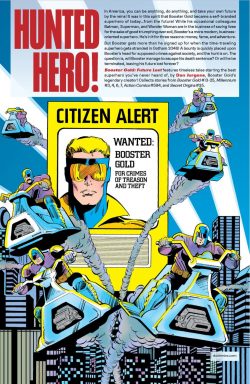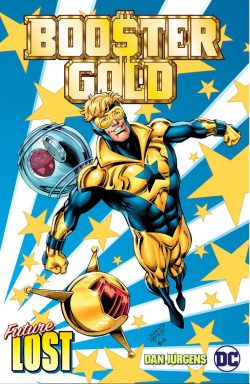

By Dan Jurgens, with John Byrne, Steve Englehart, Joe Staton, Mike DeCarlo, Ty Templeton & various (DC Comics)
ISBN: ?978-1-7795-0672-6 (HB/Digital edition)
Win’s Christmas Gift Recommendation: The Shape of Fun to Come… 8/10
After the cosmos-crunching Crisis on Infinite Earths re-sculpted the DC Universe in 1986, a host of characters got floor-up rebuilds for the tougher, no-nonsense, straight-shooting New American readership of the Reagan era. Simultaneously, a number of corporate buy-outs such as Blue Beetle, Captain Atom and The Question joined DC’s roster with their own much-hyped solo titles. There were also some all-new launches for the altered sensibilities of the Decade of Excess – the superb Suicide Squad and Shiny, Happy Hero Booster Gold.
The cobalt & yellow paladin debuted amidst heaps of hoopla in his own title (February 1986 – and the first post-Crisis premiere of a freshly integrated superhero line), presenting wholly different approaches to DC’s army of old-school costumed boy-scouts.
Created, written and drawn by Dan Jurgens, the saga featured a brash, cockily mysterious metahuman golden-boy jock who had set up his stall as a superhero in Metropolis, actively seeking corporate sponsorships, selling endorsements and with a management team in place to maximise the profit potential of his crusading celebrity.
Over fraught, fight-filled months we learned Michael Jon “Booster” Carter had been a rising sports star in the 25th century before falling in with a gambling syndicate and fixing games for cash pay-outs. When he was caught and banned from competition, he could only find menial work as a night-watchman in The Space Museum. Whilst there, he struck up a friendship with automated tour-guide/security-bot Skeets and devised a bold plan to redeem himself.
Stealing a flight ring, force-field belt, energy-rods, alien super-suit and wrist-blasters, Booster used the Museum’s prize exhibit – Rip Hunter’s time machine – to emigrate to the fabled 20th Century Age of Heroes where he might earn all the fame and glory his mistakes had cost him in his own time…
Initial success led him forming a multi-faceted company where Business manager Dirk Davis and company PA Trixie Collins later hired hotshot scientist Jack Soo to construct a second super-suit that would enable Booster to hire a camera-friendly, eye-candy girly sidekick…
Accompanied everywhere by sentient, flying, football-shaped robot Skeets, the glitzy showboat soon encountered high-tech criminal gang The 1000 and a host of super-villains, earning the ire of many sinister masterminds and the shallow approbation of models, actresses, headline-hungry journalists, politicians and the ever-fickle public…
Created, primarily written and drawn by Dan Jurgens with inks usually by Mike DeCarlo, colours from Gene D’Angelo and letters by Steve Haynie, this glittering prize of a compilation covers the end of his early days, in Booster Gold volume 1 #13-25, Millennium #3, 4, 6 & 7 and Action Comics #594, plus material from Secret Origins #35 and Who’s Who Update ’87 #1 (collectively spanning February 1987 to December 1988).
The saga resumes in the aftermath of a conclusive victory. With the threat of the 1000 ended ‘The Tomorrow Run’ (inked by Gary Martin) finds Booster at death’s door, not because of his numerous injuries but because his 25th century body has succumbed to 20th century diseases.
Set during the Legends publishing event – which saw the public turn violently against costumed heroes – the dying Carter is rescued from a mob by Trixie wearing Soo’s completed super-suit. With no other options they take Michael back to the future where he can be properly treated, even though Booster’s offences carry a mandatory death penalty in his home era…
Recruiting young Rip Hunter (destined to become the Master of Time) Trixie and Dr. Soo accompany the distressed hero to a time where ruthless Darwinian capitalism rules and everything Michael Carter once dreamed of has turned to bitter ashes. ‘A Future Lost’ (inked by DeCarlo) follows Booster and Trixie as they search for a cure (and his missing twin sister Michelle) whilst Hunter and Soo seek a means to return them all to 1986.
Booster’s illness is only cured after they are arrested: the authorities believing it barbaric to execute anybody too sick to stand up, before ‘Runback’ (inked by Bruce D. Patterson) concludes the saga in fine style with the missing Carter twin saving the day and retreating to the 20th century with the time-lost travellers.
Booster’s close call has a salutary effect on his attitudes and character. Inked by Bob Lewis, ‘Fresh Start’ sees a kinder, gentler corporate entrepreneur re-establishing his heroic credentials with the celebrity-crazed public of Metropolis, to the extent that Maxwell Lord offers him membership in the newly re-formed Justice League, just as sultry assassin Cheshire raids a biotech company recently acquired by Booster Gold International…
‘Dream of Terror’ (inked by Arne Starr) reveals all as new owner Booster learns his latest corporate asset has been making bio-toxins to eradicate all “undeserving” individuals (for which read non-white and poor) and that its creator is currently loose in Mexico City with the lethal bug. Moreover, the deranged biochemist has bamboozled militant hero Hawk into acting as bodyguard while his plans to “save humanity from itself” take effect…
DeCarlo returned to ink ‘Showdown’ in #18, as a relentless lawman from Booster’s home-time tracks him down through history, resolved to render final judgement before ‘Revenge of the Rainbow Raider’ (Al Vey inks) pit the Man of Gold against the colour-blind and utterly demented Flash villain in a 2-part thriller that sees our hero rendered sightless and his future-shocked sister go native amongst the 20th century primitives.
The tale concludes with ‘The Colors of Justice’ as Dr. Soo saves Booster even as Michelle is being kidnapped by extra-dimensional invaders…
Up until this moment the art in this volume, whilst always competent, had been suffering an annoying hindrance, designed as it was for high quality, full-colour comic books, not stark, black and white reproduction. Although legible, discernible and adequate, much of the earlier art is fine-lined, lacking contrasting dark areas and often giving the impression that the illustrations lack solidity and definition.
With Booster Gold #21 the marvellous Ty Templeton became regular inker and his bold, luscious brush-strokes brought a reassuring firmness and texture to the proceedings. As if to affirm the artistic redirection the stories became a tad darker too…
‘Invasion From Dimension X’ has Booster’s search for his missing sister impinge on a covert intrusion by belligerent aliens first encountered and defeated by the Teen Titans. To make matters worse these extra-dimensionals are using Michelle as a power-source to fuel their incursion, resulting in ‘Tortured Options’ for Booster who must choose between saving Michelle or the city of Minneapolis when the invaders open their assault with a colossal kaiju attack…
Guest-starring Justice League International, the astounding battle climaxed in public triumph and personal tragedy after which the heart-broken, embittered Booster seemingly attacks Superman in ‘All That Glisters’ (Action Comics #594, November 1987, by John Byrne & Keith Williams): a terse, brutal confrontation that crosses over and concludes in Booster Gold #23, displaying ‘Blind Obsession’ (Jurgens & Roy Richardson) as the real Man of Gold crushes a Kryptonite-powered android doppelganger designed by the world’s most unscrupulous businessman to kill Superman and frame a commercial rival…
If only they had known that at that very moment Booster Gold International was being bankrupted by a traitor at the heart of the company…
After Crisis on Infinite Earths and Legends, DC’s third mega-crossover Millennium saw Steve Englehart, Joe Staton & Ian Gibson depict how robotic Manhunters had infiltrated Earth to abort the next stage in human evolution.
Billions of years ago the Manhunters had rebelled against their creators. The Guardians of the Universe were immortal and worked towards a rational, emotionless cosmos – a view not shared by their own women. The Zamarons had abandoned the Guardians at the inception of their grand scheme but after countless millennia the two factions had reconciled and left our reality together.
Now they had returned with a plan to midwife a new race of immortals on Earth, but Manhunters had infiltrated all aspects of society throughout the universe and were determined to thwart the plan, whether by seduction, connivance or just plain brute force. The heroes of Earth gathered to protect the project and confront the Manhunters in their own private lives… and their own comics.
In its original form each weekly instalment of Millennium acted as a catalyst for events which played out across the rest of the DC Universe titles. In addition to the miniseries itself, Millennium spread across 21 titles for two months – another 37 issues – for a grand total of 44 comic-books. Issues #24 and 25 of Booster Gold were two of them and are supplemented here by pertinent excerpts of the miniseries taken from Millennium #3, 4 & 6 before ‘Betrayal’ reveals that one of Michael Carter’s inner circle has been a Manhunter agent all along. It bankrupted the hero at the most propitious moment simply so that the robots could buy his loyalty during their assault on humanity and led to all-out battle bout ‘Down’ from Millennium #7 before the series came to a shocking climax in ‘The End’ as the scheme succeeds and Booster actually switches sides …or does he?
After the surprisingly satisfying and upbeat denouement, Booster became a perennial star of Justice League International where, with fellow homeless hero Blue Beetle, he became half of the one of funniest double-acts in comics.
As “Blue and Gold” the hapless, cash-strapped odd couple were always at the heart of the action – pecuniary or otherwise – and the final tale here ‘From the Depths’ (by Jurgens & Tim Dzon, as originally seen in Secret Origins #35, December 1988), reprises the early tragic days of Michael Jon Carter in a brief and exceedingly impressive tale played as much to tug the heartstrings as tickle the funny-bone…
This compilation then closes with the entry from Who’s Who Update ‘87 #1.
As a frontrunner of the new DC, Booster Gold was a radical experiment in character that didn’t always work, but which exponentially improved as months rolled by. Early episodes might be a necessary chore but by the time this volume ends it’s a real shame that the now thoroughly entertaining and enjoyable ride is over. Perhaps not to every Fights ‘n’ Tights fan’s taste, these formative fictions are absolutely vital to your understanding of the later classics and will make any fan happy and every reader a fan.
© 1987, 1988, 2020 DC Comics. All Rights Reserved.
